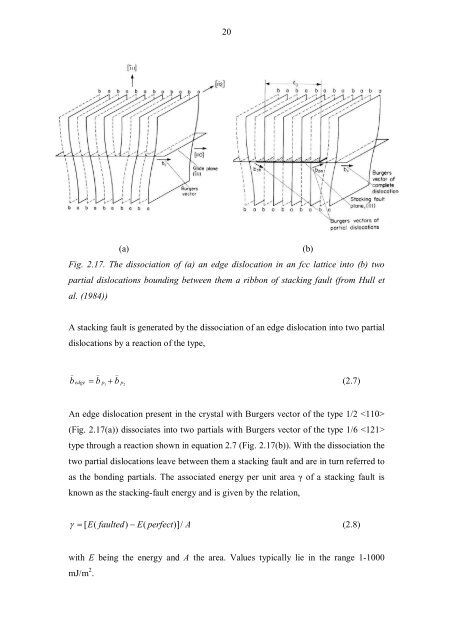Analysis of the extended defects in 3C-SiC.pdf - Nelson Mandela ...
Analysis of the extended defects in 3C-SiC.pdf - Nelson Mandela ...
Analysis of the extended defects in 3C-SiC.pdf - Nelson Mandela ...
You also want an ePaper? Increase the reach of your titles
YUMPU automatically turns print PDFs into web optimized ePapers that Google loves.
20<br />
(a) (b)<br />
Fig. 2.17. The dissociation <strong>of</strong> (a) an edge dislocation <strong>in</strong> an fcc lattice <strong>in</strong>to (b) two<br />
partial dislocations bound<strong>in</strong>g between <strong>the</strong>m a ribbon <strong>of</strong> stack<strong>in</strong>g fault (from Hull et<br />
al. (1984))<br />
A stack<strong>in</strong>g fault is generated by <strong>the</strong> dissociation <strong>of</strong> an edge dislocation <strong>in</strong>to two partial<br />
dislocations by a reaction <strong>of</strong> <strong>the</strong> type,<br />
_ _ _<br />
b edge b p b 1 p2<br />
(2.7)<br />
An edge dislocation present <strong>in</strong> <strong>the</strong> crystal with Burgers vector <strong>of</strong> <strong>the</strong> type 1/2 <br />
(Fig. 2.17(a)) dissociates <strong>in</strong>to two partials with Burgers vector <strong>of</strong> <strong>the</strong> type 1/6 <br />
type through a reaction shown <strong>in</strong> equation 2.7 (Fig. 2.17(b)). With <strong>the</strong> dissociation <strong>the</strong><br />
two partial dislocations leave between <strong>the</strong>m a stack<strong>in</strong>g fault and are <strong>in</strong> turn referred to<br />
as <strong>the</strong> bond<strong>in</strong>g partials. The associated energy per unit area γ <strong>of</strong> a stack<strong>in</strong>g fault is<br />
known as <strong>the</strong> stack<strong>in</strong>g-fault energy and is given by <strong>the</strong> relation,<br />
[ E ( faulted)<br />
E(<br />
perfect)]<br />
/ A<br />
(2.8)<br />
with E be<strong>in</strong>g <strong>the</strong> energy and A <strong>the</strong> area. Values typically lie <strong>in</strong> <strong>the</strong> range 1-1000<br />
mJ/m 2 .

















